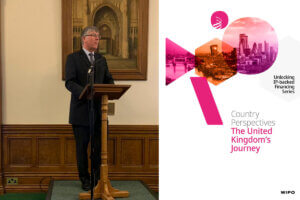By Amanda Foley and Sabreena Bari
 International Women in Engineering Day (INWED), marked on June 23rd every year since 2014, is a great opportunity to celebrate the contributions women have made in engineering around the world. But let’s also use the opportunity to explore the efforts already made towards equality and the progress yet to be made.
International Women in Engineering Day (INWED), marked on June 23rd every year since 2014, is a great opportunity to celebrate the contributions women have made in engineering around the world. But let’s also use the opportunity to explore the efforts already made towards equality and the progress yet to be made.
There is no doubt that women have made tremendous contributions in engineering, but don’t get as much credit as they deserve.
Women have had to break through huge obstacles and discrimination to get to where they are today, and even that is not far enough. As recently as the 20th century, some elements of society refused to accept that women could understand engineering at all.
Science, technology, engineering and mathematics (STEM) careers have been and continue to be largely male-dominated – even though female students often perform better than male students in these subjects.
The number of women patenting inventions has risen over the last 20 years, but it is still less than 13% of patent applications globally, according to research by the UK IPO. At the current rate, parity will be achieved by 2070. This gap can be directly linked to the lack of women working in STEM. It’s clear that to increase the number of women inventors, we need more women pursuing these subjects.
Biotech is the most gender equal STEM sector, with 53% of patents having at least one female inventor. Engineering is at the bottom of this list. So, things are going the right way in some sectors, just not engineering.
Research conducted by EngineeringUK found that female students are aware that engineering is as valid as an option as it is for male students, and this perception has improved over the past six years.
But more needs to be done to break down barriers and build up role models for potential female engineers in order to make the career path look more attainable and appealing for women.
Writing this article, both of us have spoken to female relatives and contacts about their own experiences with STEM education. What they have told us throws light on the barriers we have faced in the past, and the barriers that could still be stopping women becoming engineers or pursuing other STEM careers.
An assistant head teacher who started her career teaching science highlights the issue. With a BSc in Chemistry with Biochemistry, research and laboratory work didn’t appeal so she became a science teacher.
One crucial factor she discovered was that teaching materials and illustrations were geared towards boys. Over time, as data on gender discrepancy and the effects on options and further education emerged, and efforts were made to redress the imbalance, she says this changed, with more materials actually featuring and promoting girls in science.
Her school is actively involved in promoting STEM as a valid option for girls via various initiatives. Resources are carefully selected and are under constant review, including ensuring the language used when teaching science reflects inclusivity, while materials used in lessons are bias-free.
At the same time, she says there have been obvious attempts within the STEM Initiative to ensure gender balance and female role models, for example as STEM ambassadors at careers fairs, or during school visits to demonstrate specialist equipment and career paths.
It is reassuring that promoting the STEM initiative continues to be a high priority in schools – in fact, it is now part of her job description as assistant head teacher.
But more needs to be done. Only 12% of engineers and 16% of engineering students in the UK are female and we rank lowest in Europe with regards to female representation in the engineering workforce. Clearly,there seems to be a disconnect in the UK between a commitment to overcoming obstacles for women, and the way we ‘market’ engineering as a career for women.
We don’t give engineering the same status as medicine for women, for example. Other countries do. Spain has an almost equal split of male and female engineers. The profession is thought of very highly in Spain and male and female students go through a six-year study course at university – similar to becoming a doctor. This arguably means UK engineering needs to reposition and rebrand itself for future generations, and not just for women.
Conduct an online search for famous engineers, and what you will see is a list of men: Nikola Tesla, Elon Musk, Henry Ford, Alexander Graham Bell, Da Vinci, The Wright brothers, Alan Emtage, Isambard Kingdom Brunel…
It’s only when you add ‘Women’ to the search terms that you see some of the incredible contributions made by female engineers.
A brief selection: Edith Clarke received her first patent for the Clarke Calculator in 1921 and was the first female professional engineer employed in the US, as well as the first female professor of electrical engineering in the country; Stephanie Kwolek was the recipient of 17 US patents during her 40 years as a researcher at DuPont, including one for the invention of Kevlar; Martha Coston attained a patent in 1859 for a signal flare used by the US Navy well into the 20th Century.
These women, and many others not mentioned here, stood up for what they believed in: most importantly, they believed in themselves. They not only contributed to engineering but to gender parity and wider recognition for women everywhere.
Barriers for women entering STEM careers in general, and engineering specifically, have decreased, but they still exist and include discrimination and stereotyping, lack of support, lack of role models (Catch-22), and education systems (for example, the propensity in places like England to require students to specialise in their educational choices at an early age).
Inngot’s own Dr Alison Orr says her experience at school in Scotland, where she wasn’t required to specialise until half-way through university, gave her a much broader experience. This, she believes, meant she was in a much better position to fully understand and explore the sciences, and make informed choices for her education.
England, by contrast, expects children to choose subject options in Year 9 (around the age of 13), which determine what they study at GCSE level. Having to narrow your focus at such an early age doesn’t give children a well-informed chance to pick what they would like to pursue as a career path.
We’ve already talked about Spain’s lead in gender parity in engineering. They have a similar educational system to Scotland, where compulsory education until the age of 16 is more holistic, focusing on developing cognitive, social and critical thinking skills. Specialised education begins at age 16.
Even when women do progress into STEM careers in the UK, they are more likely to leave than men are, because of time-pressures, limited flexibility, gender pay gaps, bias from co-workers, and sexual harassment.
But although other people can be the ones putting the barriers in our way, we also have to accept that sometimes we put barriers in our own paths – or too easily accept other people’s barriers.
We need to do something about these issues, if not for ourselves, then for the coming generations.
Evidence suggests that, regardless of gender, humans are all genetically predisposed to certain skills that may or may not make us good at maths, engineering or computer science, for example.
But, given the numbers of women pursuing careers in these fields, it seems possible that some – possibly many — women with such genetic predispositions towards science are being dissuaded from following a STEM career path. Why?
As discussed above, in the past, STEM curriculums may have been unrelatable and boring for girls, with male-biased teaching and support materials; although massive steps have been taken to address these problems, there may still be an impact. The demand for early specialisation in education in England and Wales, and the ease with which students (certainly those in England and Wales) can drop subjects from them at just the point where they might become more interesting, also plays a part.
But social backgrounds and parental influence also come into play. Tests performed on students at various stages of the compulsory education system indicate that there is no real difference in the abilities of girls and boys when completing STEM classwork, though when it comes to testing, anxiety levels do seem to impact final scores achieved by girls. So, if ability isn’t the issue causing girls to move away from STEM subjects, perhaps it can be attributed, at least in part, to parental and teacher influence.
The father of one of the authors is an electronics engineer and always reinforced the importance and significance of pursuing STEM subjects equally to all his children, regardless of gender. All three children did go on to study STEM subjects in further education.
Not all families are the same, and in some, girls will still be steered away – or forbidden – from studying STEM subjects.
Every parent has witnessed first-hand how their children mimic them in everyday life, using phrases and actions they’ve picked up at home, making their adults laugh or cringe, depending on their immediate surroundings. And of course, we are all aware (and hopefully have experienced) the impact that overt, positive encouragement from our parents can have on our willingness to pursue a particular course of action.
The line between this positive encouragement and pushy parenting may be a fine one, though. And we should also consider the impact throw-away comments might be having, those off-hand remarks that we don’t give a second thought to, but our children are probably hanging onto.
If we were to comment about our own experiences in school and our aversions to, say, maths or geography to our children, will comments such as those persuade our children that they don’t like maths either, meaning that they won’t engage with the subject to the extent that they could?
Clearly, parenting pays a significant role in providing the support and encouragement a child needs in making educational choices that will shape their career paths; but even earlier than that, maybe parental influence (both conscious and unconscious) goes some way to determining the subjects that a child engages with, how they perceive them, AND how they perceive their own abilities.
Nor can we ignore the role of the teacher either. Some of us will recall an individual from our own school days, a teacher or a teaching assistant, who was particularly influential, whether positively or negatively. These individuals may not only have influenced our appreciation of a subject but may have actively encouraged us in a specific direction.
Deisi Machado, a Mechanical Engineer now working as Project Delivery Lead with the Advanced Propulsion Centre, told us about an “amazing” science teacher that she had, who she cites as the reason that she began studying Chemical Engineering at university. Although she eventually switched to Mechanical Engineering, she would never have considered engineering as a career route at all without the influence of that single teacher.
Familial and teacher influence can determine the sway that other internal barriers will have on us. A lack of self-confidence is a feeling that both men and women have experienced at one time or another, but evidence suggests that women are significantly less self-assured than men, and, given that confidence can be as important as competence in the work-place, this can be a problem.
Even the most intelligent of women, successful in their chosen fields, have admitted that they have felt unable to pursue promotions or that their success is due, in part at least, to luck or hard work rather than skill.
Another example: we spoke to a woman who is currently doing a PhD in astrophysics in her mid-thirties after more than 10 years as a successful HR manager with the NHS. She blames a lack of confidence in her abilities as a teenager for the delay in pursuing a STEM career.
This lack of confidence was undoubtedly compounded by the sexist and harmful comments made by a male physics teacher who expressed surprise that a female student had achieved the highest exam mark in the class, at the same time earnestly explaining that physics was for men. It was another 15 years before that damage could be undone.
Then there are the feelings of fear and guilt. This may revolve around ‘stereotype threat’, the idea that poor performance will compound a negative stereotype. If we don’t pursue a challenging career path, regardless of our skill level and determination to succeed, we cannot damage the reputation of other women should our efforts fail somehow.
There is also the concern that a STEM career and motherhood aren’t compatible.
We also need to acknowledge that women may consciously or unconsciously hamper the progress of other women – for example, the so-called Queen Bee effect, where successful women fail to support other women in their field, sometimes to the extent of actively enforcing the gender hierarchy and even denying that discrimination towards women exists.
To sum up, there have undoubtedly been huge improvements in equality over the last 100 years around the world.
However, as discussed above, here in the UK, while the numbers of women entering the engineering world are steadily increasing and parity between men and women is now more evident, the numbers of women in STEM careers are still lower than in many other countries, and in some industry and professional sectors, including engineering, discrimination and inequality are still rife.
This needs to change, and quickly. Women have the right to be engineers, and many of them have the aptitude. We can’t afford to waste that talent, because we will need it to tackle major problems over the next few years, like global warming and pollution. And, the timing is right, with the UK government announcing just this week the launch of a new National Science and Technology Council, which aims to put science and technology at the heart of policy-making.
Let’s ensure all children have the opportunities to make the most of their talents, whether they are for music, sports – or maths and science. And, as individuals, let’s ban negative comments and actions based around gender stereotyping, which suggest that girls can’t be scientists or engineers –because history, and a roster of great female role models, who fought for their rights, shows it just isn’t true.
If you are a female engineer who has developed potentially valuable intellectual property or intangible assets such as trademarks, copyright, non-registered rights, know-how and patents, then to celebrate Women in Engineering Day 2021, we are offering a 15% discount off our online valuation tools (Sollomon and Sollomon2) to you, if you contact us by the end of this week (5pm on Friday 25th June 2021). Call us on 0333 8008090 or email info@inngot.com quoting WED21 for your discount code.







